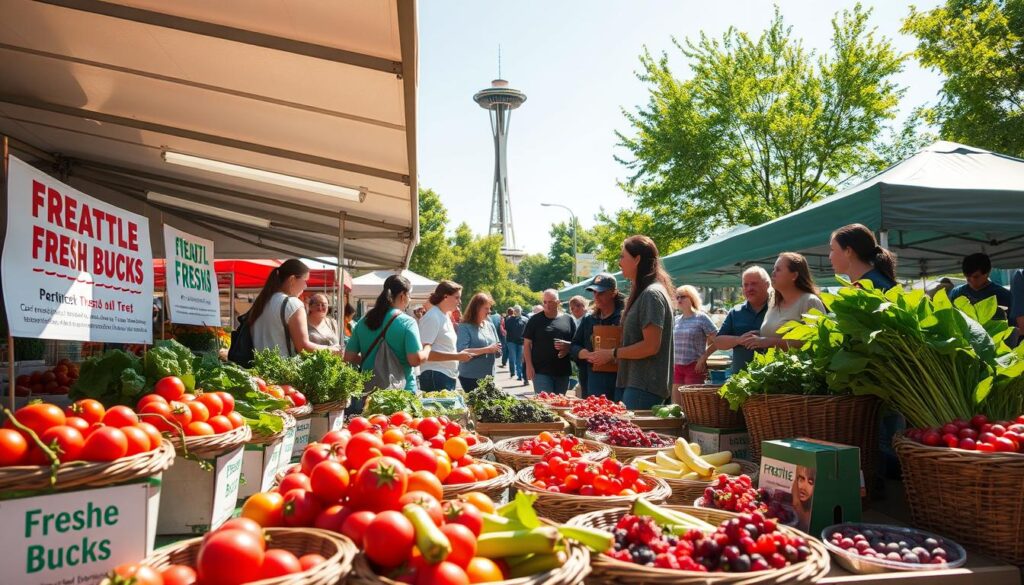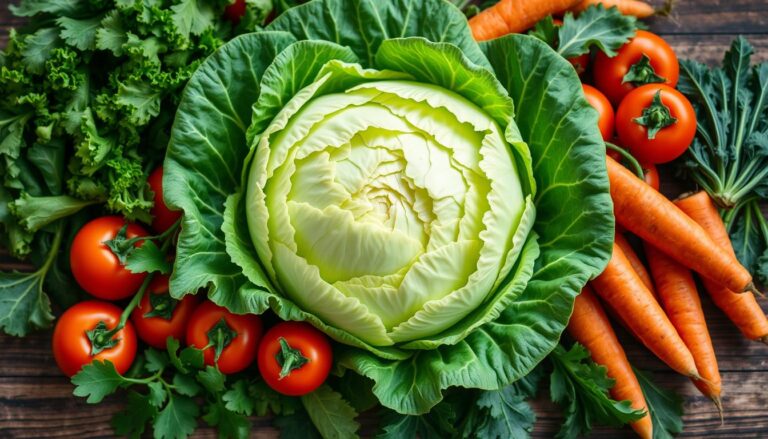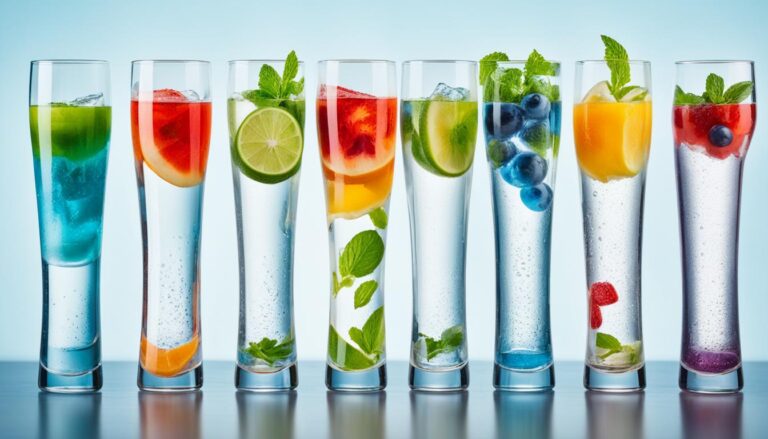Can one city benefit thousands of households simply by adding a monthly coupon for fruits and vegetables?
This question sits at the heart of a city-led program that gives direct purchasing power to families facing budget strain.
Seattle Fresh Bucks is the city’s flagship initiative to make nutritious choices easier and more affordable for people who need it most. The plan offers a simple monthly benefit redeemable at familiar spots like Safeway farmers’ markets, farm stands, and neighborhood grocers.
The reach is real: the program serves more than 12,000 households and partners with 30–40+ retailers, a network that meets residents where they already shop. Funding comes mainly from the Sweetened Beverage Tax with state support helping expand impact and nutrition security across communities.
Demand remains high, and a waitlist underscores the ongoing need. In the sections ahead, we unpack new research, who qualifies how benefits work, and why this initiative stands out among other programs.
Key Takeaways
- The program offers a monthly benefit focused on fruits and vegetables.
- More than 12,000 households currently participate across 30–40+ retailers.
- Funding is driven by the Sweetened Beverage Tax plus state support.
- High demand and a waitlist show strong local need.
- Upcoming sections explain eligibility new findings, and program impact.
New UW study finds Fresh Bucks boosts food security and fruit and vegetable intake
A University of Washington analysis tested the program’s effects by comparing benefit recipients to a waitlist group.
The August JAMA Network Open study tracked 6,900 applicants from October 2021. About 4,200 households were randomly selected to receive 2022 benefits, while others joined a program waitlist. Follow-up surveys in July 2022 yielded 1,973 responses.
Key outcomes:
- Recipients showed a 31% higher rate of food security.
- They were 37% more likely to report eating fruits and vegetables at least three times daily.
Researchers also compared returning applicants who lost benefits. Losing benefits reduced food security by 29% and cut vegetable intake by 26%, showing that effects fade when support ends.
The improvements are pretty large said Jessica Jones Smith noting policy relevance. Melissa Knox added that gains and losses mirror funding continuity.
| Measure | Change with Benefits | Change after Loss | Sample |
|---|---|---|---|
| Food security | +31% | -29% | 6,900 applicants, 1,973 surveyed |
| Fruits & vegetables ≥3/day | +37% | -26% | Randomized recipients vs. waitlist |
| Study design | Randomized assignment to benefits or waitlist | JAMA Network Open, Aug. 19 | |

Implication: Rigorous methods and clear outcome shifts make a strong case that the fresh bucks program raises intake and bolsters food security, with public-health benefits tied to better diet quality.
You may like to read: How Gut Microbes Influence Mental Well Being
Seattle Fresh Bucks Healthy Food access eligibility and how the program works
Eligibility focuses on income limits, with practical examples to guide applicants.
Who qualifies
Households earning under 80% of the area median income are eligible. For 2024, that means about $110,950 for a family of four, which helps applicants quickly assess fit.
Monthly benefit and where to use it
The program loads a $40 monthly food benefit for produce purchases. Use the benefit at farmers’ markets, Safeway farm stands, and independently owned grocery stores across the city.
This design makes it easy to choose fruits and vegetables while shopping, where families already go.
Scale administration and funding
More than 12,000 households participate through 30–40+ retailers. The Seattle Office of Sustainability and Environment runs the program.
Funding comes from the Sweetened Beverage Tax with state support to stabilize benefits. Demand exceeds supply, so many applicants join a waitlist.
- Equity focus: partners with clinics and community groups to reach underserved residents.
- Quick use case apply the $40 to greens, berries, or culturally relevant produce to stretch monthly food budgets.
| Aspect | Detail | Impact |
|---|---|---|
| Eligibility | Under 80% AMI ≈ $110,950 for a family of 4 in 2024 | Targets income qualified households |
| Benefit | $40 monthly for produce | Supports regular fruit and vegetable purchases |
| Scale & administration | 12,000+ households, 30–40+ retailers, Seattle Office of Sustainability and Environment | Broad reach, coordinated oversight |
| Funding & access | Sweetened Beverage Tax state support active waitlist | Stable funding source, high demand |

You may like to read: 7 Drinks to Burn Belly Fat
Why this program stands out implications for health systems equity and the local economy
A deliberate design choice makes this program different from standard nutrition incentives.
Beyond typical match or SNAP linked models, the Bucks program removes upfront spending and allows redemption at both a major chain and neighborhood grocers.
- No match requirement Participants do not need cash to unlock benefits lowering barriers for households facing food insecurity.
- Broader retail access Redemption at large and small stores amplifies reach and supports local vendors.
- Priority enrollment Community-based organizations and clinics focus outreach where need is highest. 76% of participants are BIPOC.
For health systems and insurers exploring food as medicine, this healthy food benefit offers a clear policy-ready model. It directs resources to produce and shows measurable gains in diet and food security useful for the health systems and program planning.
Economic ripple effects are notable. Analyses estimate about $1.50 in local impact per $1 redeemed, generating roughly $12 million from 2018 to 2020. That supports farmers’ markets, independent grocers, and a large chain retailer alike.
| Feature | What it changes | Impact |
|---|---|---|
| Redemption design | Major chain + small retailers no match | Better access, less friction for households |
| Targeting | Community enrollment clinic partners | 76% BIPOC customers have a higher reach in priority groups |
| Economic effect | $1 → $1.50 local activity | ~$12M local impact 2018–2020 |
| Health systems use | Measurable diet and security gains | A scalable model for food is medicine programs |

Conclusion
Randomized evidence shows the benefit led to measurable gains in diet and household stability. The JAMA study found a 31% higher rate of food security and a 37% increase in people eating fruits and vegetables at least three times daily.
The Bucks program pairs a simple monthly benefit with wide retailer acceptance and strong partnerships. Administration by the Seattle office of sustainability and funding from the beverage tax make delivery straightforward for more than 12,000 households.
Demand remains high, and a program waitlist signals the need to expand access. Continued investment can sustain a higher rate of food security, improve vegetable intake, and help health systems adopt proven prevention models.
Researchers like Jessica Jones Smith helped quantify the impact. Keeping and growing fresh produce will support security, diet, and local economies as more people gain steady access to fruits and vegetables.
You may like to read: Weight Loss Plan Change Your Body Shape





